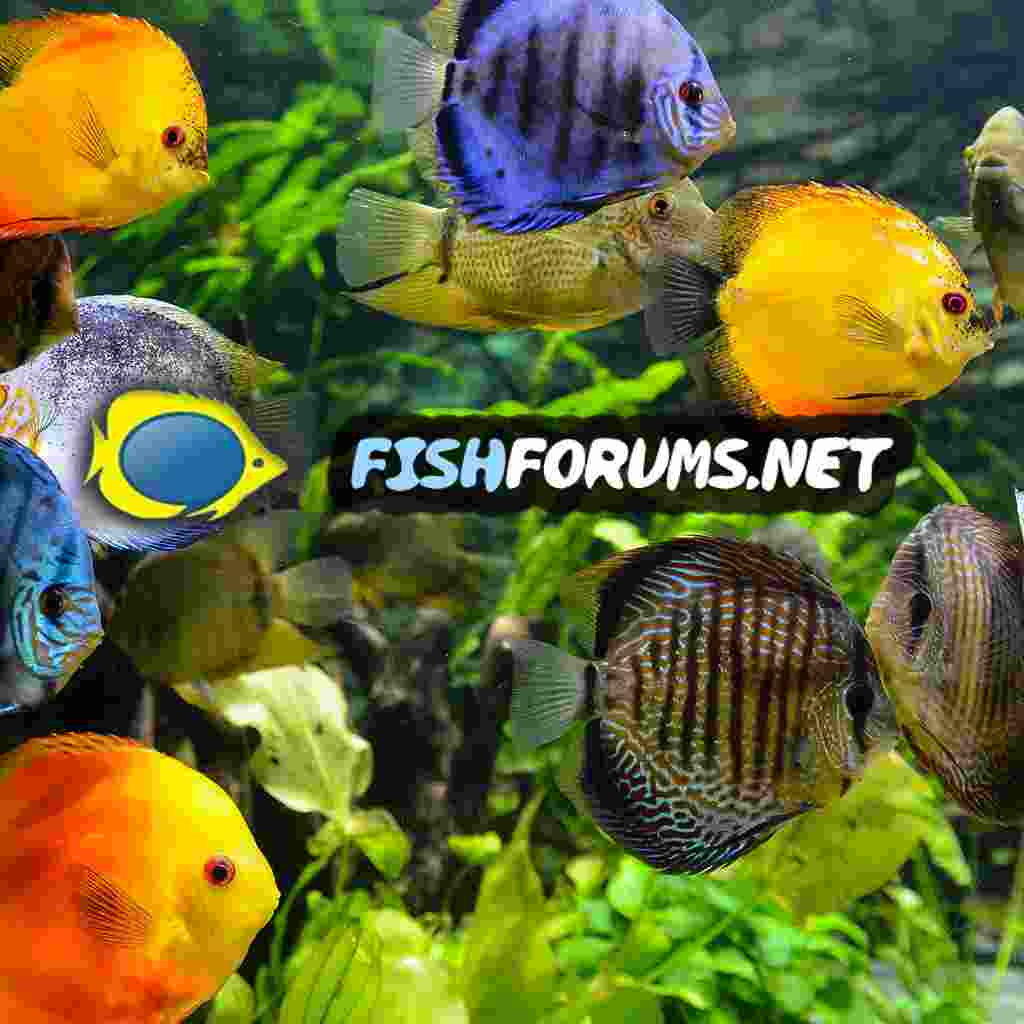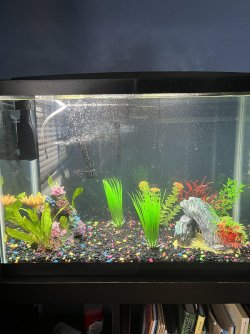So I had 6 fish and 3 have died. Before i added fish i added 20 mL of quick start 6 days before adding any fish. The tank was fully cycled about 30 hours before adding any fish. I added 2 fish a week ago on friday then 24 hours after i added 4 more. I am now left with 2 mollys and 1 platy. one of my mollys happen to give birth 2 days ago and now shes been wobbly and not moving a lot. Along with that when my first fish died it spiked the nitrites in the tank. before he died the PH was 7.4, ammonia about 0.2 nitrites 0.2 and nitrates 5.0. After he died everything stayed the same but the nitrites which spiked above 2! I was adding quick start almost daily to try and lower the ammonia and nitrites but it wasnt working. I also added 2 plants a java fern and an amazon sword but neither has helped. I am left with 3 fish and nitrites still rise above 2 ppm. I did a water change on monday about 25-30%. I did another water change on friday about 30-35%. and have done another water change today on monday about 50%. I dont know what else to do. I also added aqueon pure balls and also aquarium salt to help the molly during the birth in the rough water conditions and now i am unsure what to do. She also seems to be gasping for air even though im sure the tank is oxygenated. She ate a few of her kids along with the other molly and i think there might be one left. Any advice would be appreciated! Feel free to call me out on anything ive done wrong! I need to learn from this and hopefully save my fish!
You are using an out of date browser. It may not display this or other websites correctly.
You should upgrade or use an alternative browser.
You should upgrade or use an alternative browser.
My tropical fish need help! Nitrites keep rising above 2 ppm!
- Thread starter th3cold
- Start date
If you ever get a sick fish or a water quality problem, do a 75% water change and gravel clean the substrate every day until the problem is fixed.
Make sure any new water is free of chlorine/ chloramine before it's added to the tank.
Make sure any new water is free of chlorine/ chloramine before it's added to the tank.
Did you add ammonia to feed the bacteria in the bottle? If you didn't, you cannot know whether the tank was cycled or not. The fact that you have nitrite suggests it wasn't. Ammonia in the water is also bad for fish, especially when combined with pH over 7.
Quick Start contains the species of ammonia eaters which grow in fish tanks but it contains the wrong species of nitrite eaters.
Cutting down the amount of food you feed will reduce the amount of ammonia made by the fish, and the amount of nitrite made from that ammonia. Feeding a small amount once every 2 or 3 days won't harm the fish.
Plants won't help nitrite already in the water, but they will help by taking up ammonia made by the fish so there's less to be turned into nitrite.
There are two ways forward.
One is water changes, when ever nitrite - or ammonia - reads above zero as suggested by Colin.
The other is to use salt to mitigate the effects of nitrite until enough bacteria have grown to deal with it. The second half of this link explains the use of salt.

 www.fishforums.net
www.fishforums.net
Quick Start contains the species of ammonia eaters which grow in fish tanks but it contains the wrong species of nitrite eaters.
Cutting down the amount of food you feed will reduce the amount of ammonia made by the fish, and the amount of nitrite made from that ammonia. Feeding a small amount once every 2 or 3 days won't harm the fish.
Plants won't help nitrite already in the water, but they will help by taking up ammonia made by the fish so there's less to be turned into nitrite.
There are two ways forward.
One is water changes, when ever nitrite - or ammonia - reads above zero as suggested by Colin.
The other is to use salt to mitigate the effects of nitrite until enough bacteria have grown to deal with it. The second half of this link explains the use of salt.

Rescuing A Fish In Cycle Gone Wild - Part Il
Part II SO YOU STILL WANT TO KEEP CYCLING WITH FISH? If you are determined to ignore the above advice in Part I and still think you want to proceed with a fish in cycle, then you need to be aware of the information presented below. SOME IMPORTANT FACTS ABOUT AMMONIA Ammonia in water exists...
 www.fishforums.net
www.fishforums.net
Adding live plants will help with lowering some parameters however the plants you have there are typically categorized as slower to medium-growing plants meaning they will use less ammonia for example, as they grow slower. If you can get access to stem plants such as Limnophilia, Hornwort, Guppy grass, and Elodea they should help massively. Floating plants are a very good alternative too. Frogbit and Water Lettuce are great at dealing with problematic parameters IME.I also added 2 plants a java fern and an amazon sword but neither has helped. I am left with 3 fish and nitrites still rise above 2 ppm.
TwoTankAmin
Fish Connoisseur
No, the above is wrong. The problem is the use of the terms any time and nitrite.
The first thing to understand is that water changes slow the cycling process. Therefore, they should only be none when they are actually needed. The second thing to understand that weh a tank is initially set up and stocked, the fish are under stress even before you put them into your tank whicj will increase the stress. it is a new environment, the params may be a bit different than those to which have are accustomed and if there are tankmates of other species this may be unnerving. Then add to all of this the fact that water change at this early stage are also stressful to the fish, It is why they tend to hide during one. The good news is over time things do improve in ters of all of this. The fish settle in and adpt over time.
Now, as for the ways to deal with ammonia and/or nitrite, you can learn all about this by reading the Rescue article linked above by Essjay. It will show you how to know when to change water for ammonia and when not to. It will explain how to calculate the amount of slat needed to block any given level of nitrite with chloride which is the major part of salt, aka sodium chloride.
If you have any questions about this, feel free to shoot me a site PM. I am usually around and will answer fairly quickly.
The first thing to understand is that water changes slow the cycling process. Therefore, they should only be none when they are actually needed. The second thing to understand that weh a tank is initially set up and stocked, the fish are under stress even before you put them into your tank whicj will increase the stress. it is a new environment, the params may be a bit different than those to which have are accustomed and if there are tankmates of other species this may be unnerving. Then add to all of this the fact that water change at this early stage are also stressful to the fish, It is why they tend to hide during one. The good news is over time things do improve in ters of all of this. The fish settle in and adpt over time.
Now, as for the ways to deal with ammonia and/or nitrite, you can learn all about this by reading the Rescue article linked above by Essjay. It will show you how to know when to change water for ammonia and when not to. It will explain how to calculate the amount of slat needed to block any given level of nitrite with chloride which is the major part of salt, aka sodium chloride.
If you have any questions about this, feel free to shoot me a site PM. I am usually around and will answer fairly quickly.
Water changes don't slow the cycling process. The fish constantly produce ammonia that can be used by the filter bacteria.
Water changes dilute any ammonia, nitrite and nitrate and make the water safer for the fish so they are less likely to die from ammonia or nitrite poisoning.
Water changes dilute any ammonia, nitrite and nitrate and make the water safer for the fish so they are less likely to die from ammonia or nitrite poisoning.
Similar threads
- Replies
- 8
- Views
- 893
- Replies
- 24
- Views
- 300
- Replies
- 16
- Views
- 533




